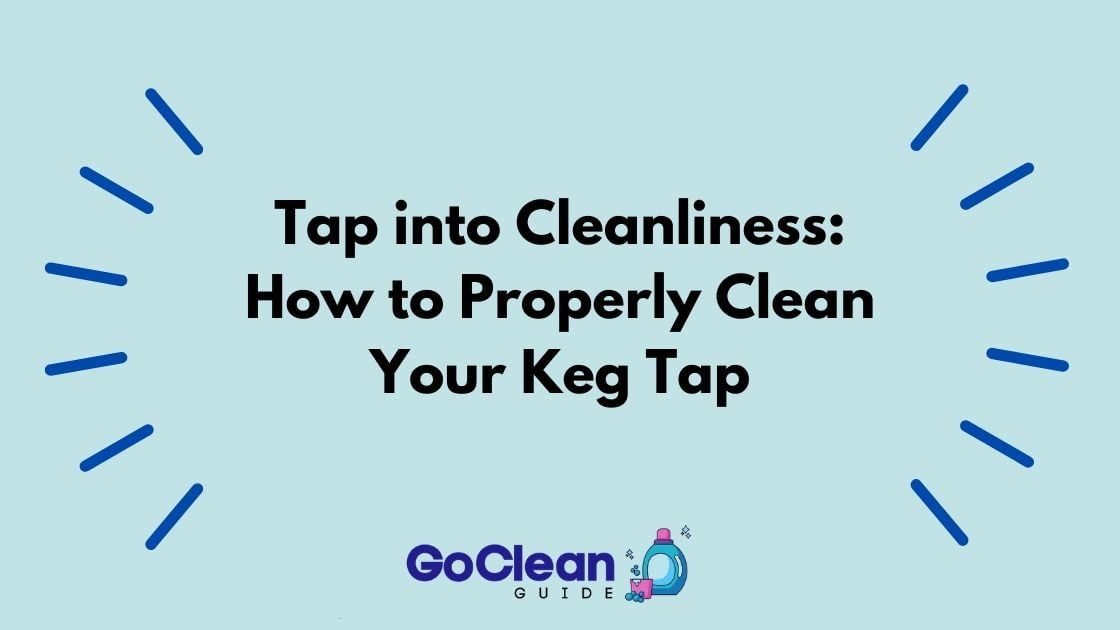Maintaining a clean keg tap is crucial for several reasons. Firstly, it ensures that your beer tastes fresh and delicious every time you pour a pint. A dirty keg tap can introduce bacteria and other contaminants into your beer, resulting in off-flavors and an unpleasant drinking experience. Secondly, regular cleaning of your keg tap helps to extend its lifespan and prevent damage. Over time, residue and buildup can accumulate in the tap, leading to clogs and leaks. Lastly, keeping your keg tap clean is essential for maintaining good hygiene standards. Bacteria and mold can grow in the tap if it is not cleaned regularly, posing health risks to both you and your customers.
To understand the importance of keg tap cleaning, it is helpful to have a basic understanding of the anatomy of a keg tap. A typical keg tap consists of several parts, including the faucet, shank, coupler, and beer line. Each part plays a crucial role in the dispensing process and requires regular cleaning to ensure optimal performance.
Understanding the Anatomy of a Keg Tap
The faucet is the part of the keg tap that controls the flow of beer. It is attached to the shank, which connects the faucet to the coupler. The coupler is responsible for connecting the keg to the tap system and allowing beer to flow from the keg to the faucet. The beer line connects the coupler to the keg, transporting the beer from the keg to the tap.
Each part of the keg tap has its own function and importance in the cleaning process. The faucet should be cleaned regularly to remove any residue or buildup that may affect the taste of the beer. The shank should also be cleaned to prevent bacteria growth and ensure a smooth flow of beer. The coupler and beer line are particularly susceptible to contamination, as they come into direct contact with the beer. Regular cleaning of these parts is essential to prevent off-flavors and maintain good hygiene standards.
The Risks of Not Cleaning Your Keg Tap
Neglecting to clean your keg tap can have several negative consequences. Firstly, dirty keg taps can pose health risks. Bacteria and mold can grow in the tap if it is not cleaned regularly, leading to potential contamination of the beer. Consuming contaminated beer can result in food poisoning and other health issues. Secondly, a dirty keg tap can negatively impact the taste of your beer. Residue and buildup in the tap can alter the flavor profile of the beer, resulting in off-flavors and an unpleasant drinking experience. Lastly, neglecting to clean your keg tap can lead to damage to both the tap itself and the beer lines. Residue and buildup can clog the tap and lines, causing leaks and other issues that may require costly repairs.
When Should You Clean Your Keg Tap?
The frequency of cleaning your keg tap depends on several factors, including how often it is used and the type of beer being dispensed. As a general rule, it is recommended to clean your keg tap every two weeks or after every keg change. However, if you are dispensing highly carbonated or hoppy beers, more frequent cleaning may be necessary to prevent clogs and off-flavors.
There are several signs that indicate your keg tap needs cleaning. If you notice a decrease in the quality of your beer’s taste or an unusual odor, it may be time to clean your tap. Additionally, if you experience difficulties with pouring or notice any leaks or clogs in the tap or lines, it is a clear indication that cleaning is needed.
Regular cleaning of your keg tap is essential for maintaining optimal performance and preventing issues such as off-flavors and clogs. By establishing a cleaning schedule and sticking to it, you can ensure that your beer always tastes fresh and delicious.
How to Disassemble Your Keg Tap for Cleaning
Disassembling your keg tap is an important step in the cleaning process. It allows you to thoroughly clean each part and remove any residue or buildup that may have accumulated. Before disassembling your keg tap, make sure to gather all the necessary tools, including a wrench, brush, and cleaning solution.
To disassemble your keg tap, follow these step-by-step instructions:
1. Turn off the CO2 supply and release any pressure in the keg by pulling the pressure relief valve.
2. Use a wrench to loosen the nut that connects the faucet to the shank. Once loosened, remove the faucet from the shank.
3. Next, use a wrench to loosen the nut that connects the shank to the coupler. Once loosened, remove the shank from the coupler.
4. Disconnect the beer line from the coupler by removing the clamp or disconnect fitting.
5. Finally, remove the coupler from the keg by twisting it counterclockwise.
When disassembling your keg tap, it is important to handle each part with care to avoid any damage. Be gentle when removing and disconnecting parts, and avoid using excessive force.
Choosing the Right Cleaning Solution for Your Keg Tap
Choosing the right cleaning solution is crucial for effectively cleaning your keg tap. There are several types of cleaning solutions available on the market, including alkaline cleaners, acid cleaners, and oxygen-based cleaners.
When choosing a cleaning solution, consider factors such as the type of residue or buildup you are trying to remove, as well as any specific instructions or recommendations from the manufacturer of your keg tap. It is important to use a cleaning solution that is specifically designed for use with keg taps, as other cleaning products may contain ingredients that can damage the tap or affect the taste of the beer.
Additionally, consider the environmental impact of the cleaning solution you choose. Look for products that are biodegradable and environmentally friendly to minimize your carbon footprint.
Step-by-Step Guide to Cleaning Your Keg Tap
Cleaning your keg tap involves cleaning each part individually and thoroughly. Follow these step-by-step instructions to ensure a proper and effective cleaning:
1. Fill a bucket or sink with warm water and add the appropriate amount of cleaning solution according to the manufacturer’s instructions.
2. Submerge the faucet, shank, coupler, and beer line in the cleaning solution. Allow them to soak for the recommended amount of time.
3. Use a brush or sponge to scrub each part, paying special attention to any areas with visible residue or buildup.
4. Rinse each part thoroughly with clean water to remove any remaining cleaning solution.
5. Allow the parts to air dry completely before reassembling your keg tap.
During the cleaning process, it is important to be thorough and ensure that all parts are cleaned properly. Pay attention to any hard-to-reach areas and use a brush or sponge to scrub away any residue or buildup.
Tips for Maintaining Your Keg Tap Between Cleanings
In addition to regular cleaning, there are several best practices you can follow to maintain a clean keg tap between cleanings:
1. Flush the lines: After each keg change, flush the lines with clean water to remove any remaining beer or residue.
2. Store properly: When not in use, store your keg tap in a clean and dry environment to prevent contamination.
3. Clean the faucet regularly: Wipe down the faucet with a clean cloth after each use to remove any residue or buildup.
4. Check for leaks: Regularly inspect your keg tap for any leaks or drips. If you notice any issues, address them promptly to prevent further damage or contamination.
5. Educate staff: If you have a commercial keg tap system, make sure to educate your staff on proper cleaning and maintenance procedures to ensure consistency and adherence to hygiene standards.
By following these tips, you can maintain a clean and well-functioning keg tap between cleanings, ensuring that your beer always tastes fresh and delicious.
Troubleshooting Common Keg Tap Cleaning Issues
While regular cleaning and maintenance can help prevent issues with your keg tap, sometimes problems may still arise. Here are some common issues that may occur during keg tap cleaning and how to troubleshoot them:
1. Clogs: If you encounter a clog in your keg tap, try using a brush or pipe cleaner to dislodge the blockage. If the clog persists, disassemble the tap and clean each part thoroughly.
2. Leaks: If you notice any leaks or drips in your keg tap, check all connections and tighten any loose fittings. If the leak persists, disassemble the tap and inspect each part for damage or wear.
3. Off-flavors: If your beer has an off-flavor after cleaning your keg tap, it may be due to residue or buildup that was not properly removed. Disassemble the tap and clean each part again, paying extra attention to any areas with visible residue.
4. Mold or bacteria growth: If you notice mold or bacteria growth in your keg tap, disassemble the tap and soak each part in a cleaning solution that is specifically designed to kill mold and bacteria. Scrub each part thoroughly and rinse with clean water before reassembling.
By troubleshooting these common issues promptly, you can prevent further damage to your keg tap and ensure that your beer remains fresh and delicious.
Enjoying Clean and Delicious Beer with a Well-Maintained Keg Tap
In conclusion, maintaining a clean keg tap is essential for enjoying fresh and delicious beer. Regular cleaning and maintenance of your keg tap not only ensure optimal taste but also prevent health risks and damage to the tap and beer lines. By understanding the anatomy of a keg tap, knowing when to clean it, and following proper cleaning procedures, you can ensure that your beer always tastes its best.
Remember to disassemble your keg tap for thorough cleaning, choose the right cleaning solution, and follow a step-by-step guide to clean each part effectively. Additionally, follow best practices for maintaining your keg tap between cleanings and troubleshoot any issues that may arise promptly.
By following these guidelines and maintaining a clean and well-maintained keg tap, you can enjoy fresh and delicious beer every time you pour a pint. Cheers!
FAQs
What is a keg tap?
A keg tap is a device used to dispense beer from a keg. It is typically made up of a spout, a handle, and a valve that controls the flow of beer.
Why is it important to clean a keg tap?
Cleaning a keg tap is important to prevent the growth of bacteria and other harmful microorganisms that can contaminate the beer. It also helps to maintain the quality and taste of the beer.
How often should a keg tap be cleaned?
A keg tap should be cleaned after every use to prevent the buildup of bacteria and other contaminants. It is also recommended to do a deep cleaning every few weeks to ensure the tap is thoroughly sanitized.
What is the best way to clean a keg tap?
The best way to clean a keg tap is to disassemble it and soak the parts in a cleaning solution. Use a brush to scrub away any buildup or residue, and rinse thoroughly with water. Allow the parts to air dry before reassembling the tap.
What cleaning solution should be used to clean a keg tap?
A cleaning solution specifically designed for cleaning keg taps should be used. These solutions are typically made up of a combination of chemicals that are effective at removing buildup and sanitizing the tap.
Can a keg tap be cleaned with soap and water?
While soap and water can be used to clean a keg tap, it is not recommended as it may not effectively remove all bacteria and contaminants. Using a cleaning solution specifically designed for keg taps is the best way to ensure the tap is thoroughly sanitized.






